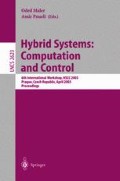Abstract
A hybrid system is proposed to model the electrical potential emitted by a neuron as a response to an externally applied DC current. Experimentally, Hodgkin and Huxley built a four-dimensional and nonlinear dynamical system to simulate this activity. Our idea is to use a new continuous and piecewise affine approximation as a hybrid model of the Hodgkin-Huxley dynamic. Our new model reproduces the Hodgkin- Huxley features with good accuracy (e.g. including the fact that the incoming current intensity is a bifurcation parameter), and, moreover, still allows an analytic computation of its solutions.
Access this chapter
Tax calculation will be finalised at checkout
Purchases are for personal use only
Preview
Unable to display preview. Download preview PDF.
References
L.F. Abbott and T. Kepler. Model neurons: From hodgkin-huxley to hopfield. In L. Garrido, editor, Statistical Mechanics of Neural Networks, pages 5–18. Springer-Verlag, Berlin, 1990.
Eugene Asarin, Thao Dang, and Antoine Girard. Reachability of non-linear systems using conservative approximations. In Proceedings of the 2003 Hybrid Systems: Computation and Control, Prague, The Czech Republic, April 2003.
E.J. Doedel, R.C. Paffenroth, A.R. Champneys, T.F. Fairgrieve, Yu.A. Kuznetsov, B. Sandstede, and X. Wang. Auto 2000: Continuation and bifurcation software for ordinary differential equations (with homcont). Technical report, California Institute of Technology, February 2001. http://auto2000.sourceforge.net.
Jean Della Dora, Aude Maignan, Mihaela Mirica-Ruse, and Sergio Yovine. Hybrid computation. In Bernard Mourrain, editor, Proceedings of the 2001 International Symposium on Symbolic and Algebraic Computation, London, Ontario, Canada. ACM Press, New York, July 2001.
Hidekazu Fukai, Shinji Doi, Taishin Nomura, and Shunsuke Sato. Hopf bifurcations in multiple-parameter space of the hodgkin-huxley equations i. global organization of bistable periodic solutions. Biological Cybernetics, 82:215–222, 2000.
Hidekazu Fukai, Shinji Doi, Taishin Nomura, and Shunsuke Sato. Hopf bifurcations in multiple-parameter space of the hodgkin-huxley equations ii. singularity theoretic approach and highly degenerate bifurcations. Biological Cybernetics, 82:223–229, 2000.
Wulfram Gerstner and Werner M. Kistler. Spiking Neuron Models: Single Neurons, Populations, Plasticity. Cambridge University Press, August 2002.
Antoine Girard. Approximate solutions of ordinary differential equations using piecewise linear vector fields. In Proceedings of the 2002 Computer Algebra in Scientific Computing, Big Yalta, Ukraine. Springer-Verlag, September 2002.
A.L. Hodgkin and A.F. Huxley. A quantitative description of membrane current and its application to conduction and excitation in nerve. Journal of Physiology, 177:500–544, 1952.
Frank C. Hoppensteadt. An Introduction to the Mathematics of Neurons: Modeling in the Frequency Domain. Number 14 in Cambridge Studies in Mathematical Biology. Cambridge University Press, 2 edition, 1997.
Frank C. Hoppensteadt and Charles S. Peskin. Modeling and Simulation in Medicine and Life Sciences. Springer-Verlag, 2 edition, 2002.
E.M. Izhikevich. Neural excitability, spiking, and bursting. International Journal of Bifurcation and Chaos, 10:1171–1266, 2000.
Eugene M. Izhikevich. Resonate-and-fire neurons. Neural Networks, 14(6–7):883–894, 2000.
Yu.A. Kuznetsov and V.V. Levitin. Content: integrated environment for analysis of dynamical system, 1997. http://www.maths.ex.ac.uk/∼hinke/courses/Content.
James D. Murray. Mathematical Biology. Springer-Verlag, Heidelberg, 3 edition, 1993.
Arnaud Tonnelier. Dynamique non-linéaire et bifurcations en neurosciences mathématiques. PhD thesis, Université Joseph Fourier, Grenoble, France, October 2001.
Author information
Authors and Affiliations
Editor information
Editors and Affiliations
Rights and permissions
Copyright information
© 2003 Springer-Verlag Berlin Heidelberg
About this paper
Cite this paper
Dumas, JG., Rondepierre, A. (2003). Modeling the Electrical Activity of a Neuron by a Continuous and Piecewise Affine Hybrid System. In: Maler, O., Pnueli, A. (eds) Hybrid Systems: Computation and Control. HSCC 2003. Lecture Notes in Computer Science, vol 2623. Springer, Berlin, Heidelberg. https://doi.org/10.1007/3-540-36580-X_14
Download citation
DOI: https://doi.org/10.1007/3-540-36580-X_14
Published:
Publisher Name: Springer, Berlin, Heidelberg
Print ISBN: 978-3-540-00913-9
Online ISBN: 978-3-540-36580-8
eBook Packages: Springer Book Archive

